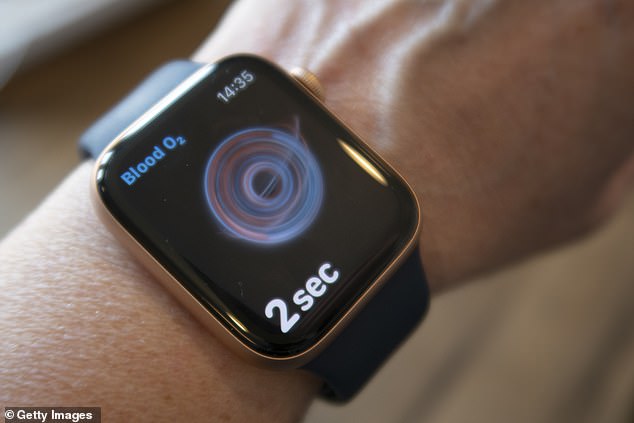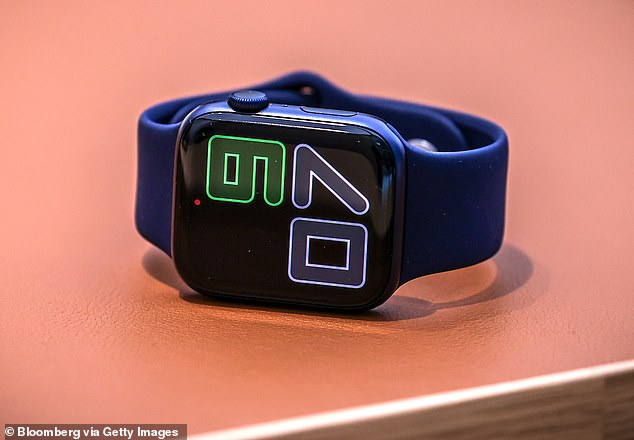Apple Watches may include a blood pressure sensor and fertility tool from as early as next year, as part of a series of new health-related features the tech giant is believed to be working on.
Leaked documents also suggest the company is looking to improve how its smartwatches track sleep patterns and monitor irregular heartbeats.
It is expected to release its seventh version of the Apple Watch in the coming weeks, reportedly with a larger display and a new flat-edged design, but most of the more advanced health features are not expected until 2022 at the earliest.

Apple Watches may include a blood pressure sensor and fertility tool from as early as next year, as part of a series of new health-related features. Pictured is an Apple Watch Series 6
Beyond that, Apple also wants its watches to detect sleep apnea, provide medical guidance when they sense low blood oxygen levels, and even one day spot diabetes, according to people close to the company who spoke to the Wall Street Journal.
According to The Journal, Apple is looking at a proxy that measures the speed of the wave of a heart beat that goes through a person’s arteries using sensors inside the Watch.
Presently, blood pressure is most commonly measured via inflatable cuffs around a person’s arm.
However, they cautioned that many features being looked at may either be delayed or never rolled out to customers.
One of Apple’s reported aims is for its watch to take a person’s temperature by next year, which could also be used for fertility planning by giving women clues about where they are in their ovulation cycle, a source said.
MailOnline has approached Apple for a comment but the company is yet to respond.
The tech giant has increasingly been positioning the Apple Watch as a wellness tool: SCC filings first reported in May 2021 suggested the company was tapping UK-based Rockley Photonics to develop non-invasive sensors that can measure blood pressure, blood sugar and other biochemical markers.
The Apple Watch 6 was the first to read blood oxygen levels, but if the new technology makes it into future models it could have implications for the more than 436 million people worldwide who have diabetes.

The Apple Watch 6 (pictured) was the first to read blood oxygen levels. But future models may include a thermometer to help with fertility planning and a blood pressure measurement tool
Rockley Photonics’ products track various health functions non-invasively with infrared, including body temperature, blood pressure and glucose, alcohol and oxygen levels in the blood.
Apple CEO Tim Cook personally test-drove a blood-glucose tracker in 2017, and there were rumours such a monitor would come with the Apple Watch Series 7 next month.
However, Bloomberg journalist Mark Gurman said these were not true and that it will probably not arrive until 2022 at the earliest, in the form of a body-temperature monitor. He also said the latest model would not include a blood pressure sensor.
In the latest edition of his Power On newsletter, Gurman said the Series 7 will come with a variety of new watch faces to complement the bigger display.
‘While last year’s upgrade centered on the blood-oxygen sensor, this year’s [upgrade] is all about a new design with a flatter display and edges, a faster processor and slightly larger screens,’ he wrote.
‘I’m told that Apple will bundle multiple new watch faces to take advantage of the bigger screen, including an updated Infograph Modular face.’
The mooted new design will put the watch in line with the latest iPhones, which swapped curved edges for flat ones.
Gurman confirmed the Series 7 will be available in 41- and 45-millimeters sizes, up from 40 and 44 millimeters for the Series 6.
Details about the Apple Watch 7 are expected to be formally announced alongside the iPhone 13 at the company’s September event, which could happen as soon as September 8.
HAVE APPLE WATCHES EVER ACTUALLY SAVED LIVES?
In 2018, a Michigan woman saved her drowning husband’s life by calling 911 on her Apple Watch. But that’s not the first time the wearable has helped owners in dire circumstances.
In April 2017, Casey Bennett of Laytonsville, Maryland, was driving home from school when he was struck by another vehicle, sending him and his Jeep Patriot flying through the air.

A 28-year-old was able to get lifesaving treatment for a pulmonary embolism because his Apple Watch detected a sudden rise in his heart rate
Bennett, 22, found himself hanging from the driver’s seat by just his seat belt, with his iPhone too far out of reach to call for help.
However, he remembered his Apple Watch included an SOS Emergency feature and held the side button down to contacted emergency rescuer worker, who were on the scene in six minutes.
Many wearers use the Apple Watch’s heart-monitoring capabilities to catch cardiac issues early.
James Green, 32, said in 2017 his timepiece notified him of a sudden rise in his heart rate, a sign of a possible pulmonary embolism.
Green had already suffered a life-threatening clot before and raced to the hospital, where doctors found a new clot on his lungs, which could have killed him in minutes if left untreated.
He says the only reason he is only alive is because of that notification.
‘Never thought a stupid lil [sic] wrist computer I bought two years ago would save my life,’ Green tweeted. ‘Saw my heart rate go up, ended up being a pulmonary embolism.’
Advertisement
Source link : https://www.dailymail.co.uk/sciencetech/article-9947851/Apple-Watches-blood-pressure-sensor-fertility-tool-2022.html











